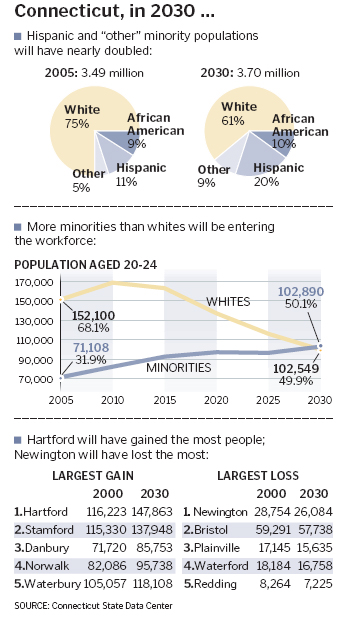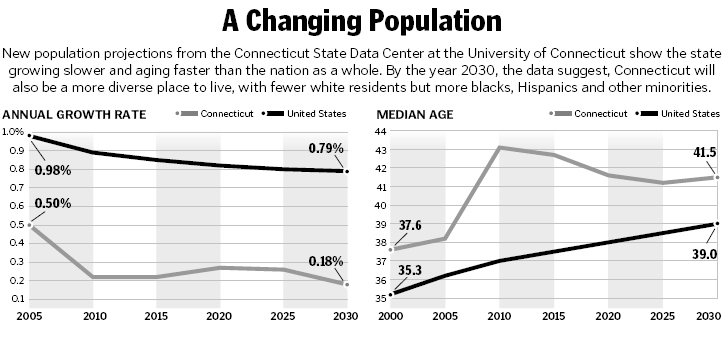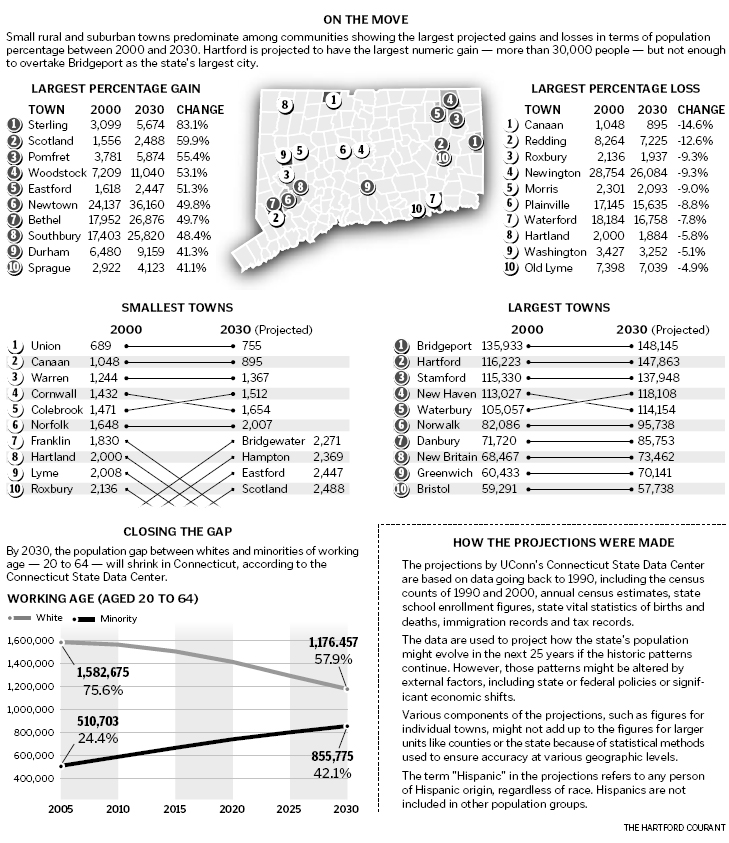 |
 |
|||
|
||||
| Web Sites, Documents and Articles >> Hartford Courant News Articles > | ||
|
Change Is On The Way May 16, 2007 A new demographic portrait of the state shows Connecticut growing slower and aging faster than the nation as a whole in the next 25 years, with a population that will look much different in 2030. The state's white population will shrink, according to the projections by University of Connecticut demographers, while the black population will grow by about 16 percent. The numbers of Hispanics and "other" minorities - mostly, mainland Chinese and East Asian Indians - will both nearly double. Perhaps the most sobering assessment is that the state's total working age population - 20- to 64-year-olds - will decline by 2030, according to UConn's Connecticut State Data Center. Hispanic, black and other minority workers will be a much larger part of the labor pool, more than 40 percent, compared with about 24 percent now.
Although the projections do not extend beyond 2030, they suggest that those labor trends will continue: The total population of 20- to 24-year-olds just entering their working years drops much more quickly than the working population as a whole, and more than half of those new workers will be minorities. Orlando Rodriguez, a demographer at UConn's data center, said the new projections suggest that Connecticut's cherished affluence might be in danger. "The biggest issue for me is the middle class," Rodriguez said. "The minority population historically has not had the same economic success, for whatever reason." One issue is education, he said. In the coming years, more than 40 percent of the new 20- to 24-year-old minority workers will come from what the data center characterizes as "urban core" communities - lower-income cities, many of which have troubled school systems that send fewer students to college than wealthier districts. Another 30 percent or more are in "urban periphery" towns - mostly older, inner-ring suburbs, some of which also have struggling schools. "For Connecticut to maintain its median income," Rodriguez said, "it's going to have to either bring in people with more education or do a better job of educating low-income people." "We're losing the baby boomers ... and there's no one to replace them," West Hartford economist Ron Van Winkle said. "We need to take the people we have and make sure they get well-educated." The trends outlined by the projections are not new. The U.S. Census Bureau's projections show a similar decline in workers between 2005 and 2030, and last year a report commissioned by the Nellie Mae Education Foundation predicted that the labor pool in most New England states would include more minorities and fewer college graduates by 2020. But the projections - the first the state has done in more than a decade - provide details unavailable elsewhere, including town-by-town growth estimates. The UConn estimates also differ from other reports about the rates at which population changes will take place. For example, the Nellie Mae report, "New England 2020," forecast that Connecticut's working population - which it defined as 25- to 64-year-olds - would be almost 28 percent minority by 2020. The UConn projections say that the minority makeup of that age group will be nearly 34 percent by then. Census projections say that the state's overall growth will be stronger early in the 2005-2030 period before tapering off and actually dropping after 2025. The UConn projections say that the state's total population will increase at a relatively steady if sluggish pace between 2005 and 2030 - just under a quarter of a percent a year, on average. But the number of 20- to 64-year-olds is projected to grow more rapidly between 2005 and 2015, gaining more than 3.5 percent, before plunging almost 6.3 percent in the following 15 years. Van Winkle said that the scarcity of workers might force some employers - especially those rooted to the state, such as state and local governments - to raise wages to attract workers from elsewhere. "Other companies may decide, `We can't grow here,' and move," he said. Older workers might help mitigate some of the economic harm, Van Winkle said. Assuming that work life ends at 64 has become "outmoded" in recent years, he said, for a variety of reasons: People are healthier for longer; the stock market collapse of 2001 eroded retirement savings; concerns about Social Security might lead some people to delay retirement. But longer term, the total population isn't expected to grow enough to allow for the economic expansion expected in other parts of the country. "The underlying problem is the low fertility rate," Rodriguez said. Connecticut's birth rate is 1.8 children per woman; the rate necessary for a stable population is 2.1. White, black, Hispanic and other ethnic groups in the state all have lower birth rates than their counterparts nationally, he said. "Not only are we not having enough children," he said, "but people are leaving." The state loses large numbers of college graduates to places with hotter job markets, Rodriguez said. Other trends indicated by the projections: The most affluent communities - those classified as "wealthy" and "suburban" by the data center - will grow the fastest, by 19.2 percent and 15.7 percent, respectively, between 2005 and 2030. Middlesex and Windham counties will be the fastest-growing of the state's eight counties, gaining 14.8 percent and 13 percent, respectively. Slowest-growing: Hartford and New London counties, at 2.5 percent each. The median ages of all groups will increase by 2030. Hispanics will remain the youngest, with the median age increasing from 26.5 years in 2005 to 31.4. Whites will remain the oldest group, going from 42.4 years to 46.2. The median age of blacks will increase from 31.4 years to 37.1 and of other minorities from 32 years to 40. The black and Hispanic populations will remain concentrated in the urban core and urban periphery communities: Those 37 of the state's 169 cities and towns are projected to be home to more than 90 percent of both communities in both 2005 and 2030.
|
||
| Last update:
September 25, 2012 |
|
||
|



